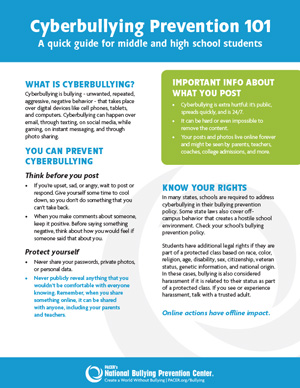In This Section
Cyberbullying Prevention 101 | Quick Guide
A quick guide for middle and high school students.
What is Cyberbullying?
Cyberbullying is bullying – unwanted, repeated, aggressive, negative behavior – that takes place over digital devices like cell phones, tablets, and computers. Cyberbullying can happen over email, through texting, on social media, while gaming, on instant messaging, and through photo sharing.
You Can Prevent Cyberbullying
Think before you post
- If you’re upset, sad, or angry, wait to post or respond. Give yourself some time to cool down, so you don’t do something that you can’t take back.
- When you make comments about someone, keep it positive. Before saying something negative, think about how you would feel if someone said that about you.
Protect yourself
- Never share your passwords, private photos, or personal data.
- Never publicly reveal anything that you wouldn’t be comfortable with everyone knowing. Remember, when you share something online, it can be shared with anyone, including your parents and teachers.
Important Info About What You Post
- Cyberbullying is extra hurtful: it’s public, spreads quickly, and is 24/7.
- It can be hard or even impossible to remove the content.
- Your posts and photos live online forever and might be seen by parents, teachers, coaches, college admissions, and more.
Know Your Rights
In many states, schools are required to address cyberbullying in their bullying prevention policy. Some state laws also cover offcampus behavior that creates a hostile school environment. Check your school’s bullying prevention policy.
Students have additional legal rights if they are part of a protected class based on race, color, religion, age, disability, sex, citizenship, veteran status, genetic information, and national origin.
In these cases, bullying is also considered harassment if it is related to their status as part of a protected class. If you see or experience harassment, talk with a trusted adult.
Online actions have offline impact
When You See Cyberbullying, Be An Advocate For Others
Choose not to participate in the bullying
- You may feel pressure to join in if a lot of other people are involved
- Don’t “like” or share posts that bully someone
- You can make your own choice on how to handle the situation: make it a positive one
Respond with positive support
- If you feel comfortable, and if it’s safe for you, publicly show your support for the person being targeted. Even one nice comment among a bunch of mean ones can make a world of difference.
Reach out to the person being bullied
- Send them a private message letting them know that you don’t agree with what’s happening, they don’t deserve to be treated that way, and they’re not alone
- Encourage them to report the bullying or tell an adult and offer to help them do that
When Cyberbullying Happens To You, Take Action
Save everything and print what you can
- Report content like harassment, fake profiles, and inappropriate photos to the social media platform or internet service provider and show an adult. If that person is unable to help, find another adult.
Know who can access your information
- Block individuals who are not respectful
- Limit access to people you want to interact with
You don’t have to go through the experience alone. Ask for help.
- Let an adult know what is happening. Tell a parent or other trusted adult, whether at school or in the community, such as a teacher, counselor, coach, or relative.
Choose kindness, acceptance, and inclusion
HOW TO TELL AN ADULT ABOUT CYBERBULLYING
Cyberbullying is often done in online spaces where parents or teachers may not be present. Since it’s up to adults to enforce the rules, it’s important to tell someone so they can act. If that person is unable to help, find another adult.
Teens are often told to tell an adult, but how do you do that? Try saying:
- “I saw a post with several mean comments about someone I know, what should I do?”
- “I want to tell you about a text I got today, can we talk more?”
- “Somebody posted something that made me feel ___________.”
- (Sad • Hurt • Mad • Embarrassed • Worried • Scared)
